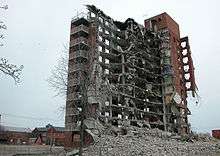Cochran Gardens
Cochran Gardens was a public housing complex on the near north side of downtown St. Louis, Missouri. Construction was completed in 1953.[1] The complex was occupied until 2006, it was famous for its residents' innovative form of tenant-led management. In 1976, Cochran Gardens became one of the first U.S. housing projects to have tenant management. Built by the same firm, Leinweber, Yamasaki & Hellmuth,[2][3] as the infamous Pruitt–Igoe complex, Cochran Gardens was more successful than its ill-fated sister project. In the mid 1970s, Bertha Gilkey and a group of friends successfully led a community driven rehabilitation effort; in 1976 she won a property management contract from the city.[4] Independent management improved Cochran Gardens and created small business jobs in the neighborhood.[5] President George H. W. Bush visited the site in 1991, commending tenant management and Bertha Gilkey. However, in 1998 city authorities took over Cochran Gardens, citing tax mismanagement by the tenant association. The buildings rapidly deteriorated, by 1999 vacancy rate increased from under 10% to one-third.


Cochran Gardens, which survived into the 21st century, was demolished in 2008.[6]
See also
- Pruitt–Igoe, in St. Louis, Missouri
- Cabrini–Green, in Chicago, Illinois
- Robert Taylor Homes, in Chicago, Illinois
- St. James Town, in Toronto, Canada
- Ballymun Flats, in Dublin, Ireland
- Red Road (flats), in Glasgow, Scotland
- Panel house, in various communist countries
Notes
- Wright, John Aaron (2002). Discovering African American St. Louis: A Guide to Historic Sites. St. Louis, Missouri: Missouri History Museum.
- "Built St. Louis | Vanished Buildings | Cochran Gardens". builtstlouis.net. Retrieved 2015-05-17.
- http://www.emporis.com/en/wm/cx/?id=100775
- "A Public Housing Success Story [Mackinac Center]". mackinac.org. Retrieved 2015-05-17.
- Weisman, L.K. (1994). Discrimination by Design: A Feminist Critique of the Man-Made Environment. University of Illinois Press. ISBN 9780252063992. Retrieved 2015-05-17.
- "Ecology of Absence: Cochran Gardens Demolition Nearing Completion". ecoabsence.blogspot.com. Retrieved 2015-05-17.
Further reading
- Checkoway, Barry (1985). "Revitalizing an Urban Neighborhood: A St. Louis Case Study'". The Metropolitan Midwest. Urbana/Chicago: University of Illinois Press. ISBN 978-0-252-01114-6.
- Hall, Peter Geoffrey Hall (2004). Cities of Tomorrow: An Intellectual History of Urban Planning and Design in the Twentieth Century. Hoboken, NJ: Wiley, John & Sons, Incorporated. ISBN 978-0-631-23252-0.
- Jencks, Charles (1984). The Language of Post-Modern Architecture. New York: Rizzoli. ISBN 978-0-8478-0571-6.
- Larsen, Lawrence Harold; Kirkendall, Richard Stewart (2004). A History of Missouri: 1953 to 2003. University of Missouri Press. ISBN 978-0-8262-1546-8.
- Mendelssohn, Robert E.; Quinn, Michael A. (1985). "Residential Patterns in a Midwestern City: The Saint Louis Experience". The Metropolitan Midwest. Urbana/Chicago: University of Illinois Press. ISBN 978-0-252-01114-6.
- Montgomery, Roger (1985). "Pruitt–Igoe: Policy Failure or Societal Symptom". The Metropolitan Midwest. Urbana/Chicago: University of Illinois Press. ISBN 978-0-252-01114-6.
- Patterson, James T. (1997). Grand Expectations: The United States, 1945-1974. Oxford University Press US. ISBN 978-0-19-511797-4.
- Rainwater, Lee (2006). Behind Ghetto Walls: Black Families in a Federal Slum. Chicago: Aldine Transaction. ISBN 978-0-202-30907-1.
- Weisman, Leslie K. (1994). Discrimination by Design: A Feminist Critique of the Man-Made Environment. University of Illinois Press. ISBN 978-0-252-06399-2.